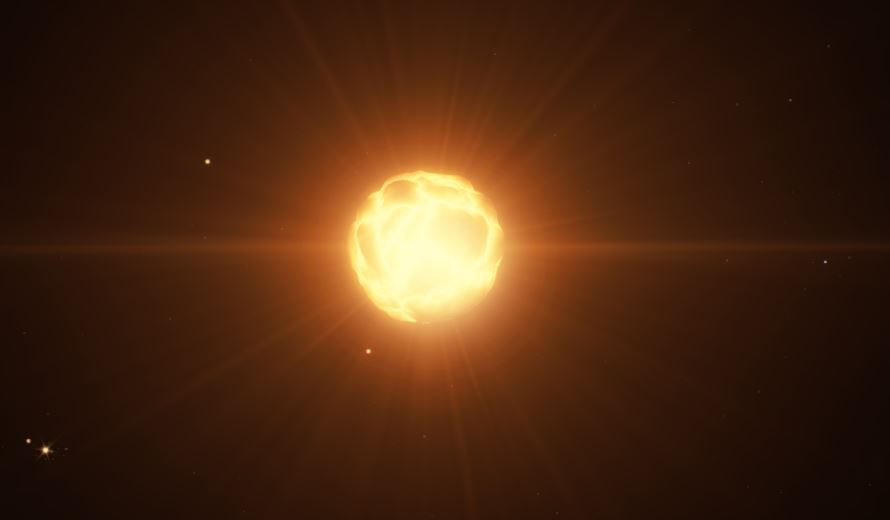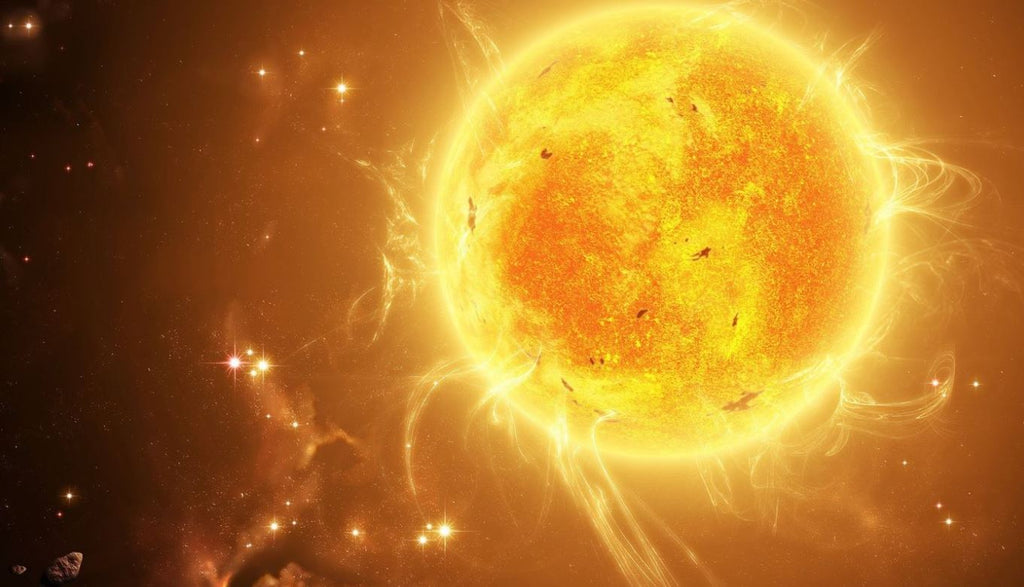Aldebaran Star: Type, Age, Size, Diameter, Mass, Temperature, Color and Distance from Earth
Aldebaran is one of the most well-known stars in the night sky, and it is easily recognizable by its bright red color and its location in the constellation Taurus. It is a giant star, and its size and brightness make it an important object of study for astronomers. In this article, we will explore the characteristics of Aldebaran and what makes it such an intriguing and fascinating star.
What is Aldebaran Star?
Aldebaran is a red giant star that is located approximately 65 light-years from Earth in the constellation Taurus. It is the brightest star in the constellation and the 14th brightest star in the night sky. It has a diameter that is approximately 44 times larger than the diameter of the Sun, and it is estimated to be around 1.7 times the mass of the Sun.
Aldebaran is a relatively young star, with an estimated age of around 1 billion years. It is also a variable star, which means that its brightness varies over time. This variability is caused by pulsations in the star's outer layers, which cause its radius and temperature to change.

Characteristics of Aldebaran Star
Aldebaran is classified as a K5 III type star, which means that it is a red giant star that has exhausted the hydrogen fuel in its core and is currently fusing helium. It has a surface temperature of around 3,910 K, which gives it its distinctive red color.
Aldebaran's brightness varies over time, and it has a magnitude range of approximately 0.75 to 0.95. It is a relatively bright star, and it can be seen with the naked eye from most locations on Earth.

Aldebaran Star Type
As we cast our gaze toward the heavens, Aldebaran star emerges as a majestic red giant, classified as a type-K star. Its radiant brilliance and distinct attributes make it a captivating presence in the celestial tapestry.
Aldebaran Star Age
The age of Aldebaran star holds the key to its cosmic history. With an approximate age of around 6.6 billion years, Aldebaran has journeyed through epochs, evolving and transforming into the luminous spectacle that graces our night sky.
Aldebaran Star Size
Size is a defining factor in the realm of stars, and Aldebaran star's dimensions are a testament to its cosmic grandeur. With a radius of about 44.2 times that of our Sun, Aldebaran commands attention with its radiant luminosity.
Aldebaran Star Diameter
The diameter of Aldebaran star invites us to contemplate the vastness of the universe. Spanning an approximate distance of 61.8 million kilometers (38.4 million miles), Aldebaran's diameter emphasizes the colossal scale that celestial objects can attain.
Aldebaran Star Mass
Mass serves as a cornerstone in deciphering a star's behavior and cosmic journey. Aldebaran star's mass, estimated to be about 1.7 times that of our Sun, plays a pivotal role in shaping its luminosity and the intricate processes transpiring within its core.
Aldebaran Star Temperature
The temperature of a star's surface defines its appearance and color. Aldebaran star boasts a warm surface temperature of approximately 3,910 degrees Celsius (7,070 degrees Fahrenheit), enveloping it in a captivating orange glow that graces our night sky.
Aldebaran Star Color
Color is an integral aspect of stars, providing insights into their nature. Aldebaran star's spectral color, a captivating orange-red hue, reflects its type-K classification. This unique color sets it apart in the vast cosmic expanse.
Aldebaran Star Distance from Earth
Located in the Taurus constellation, Aldebaran star graces our night sky from a distance of approximately 65.1 light-years. Despite this cosmic journey, its luminosity reaches us, allowing us to bask in its radiant glow and ponder the mysteries of the universe.
Aldebaran Star Specifications
Here's a detailed specification table for Aldebaran star, highlighting its key characteristics:
Detailed Specification Table: Aldebaran Star
| Characteristic | Details |
|---|---|
| Star Type | Type-K Red Giant |
| Age (approx.) | ~6.6 billion years |
| Radius | ~44.2 times Sun's radius |
| Diameter | ~61.8 million km (38.4 million miles) |
| Mass | ~1.7 times Sun's mass |
| Surface Temperature | ~3,910°C (7,070°F) |
| Spectral Color | Captivating Orange-Red |
| Distance from Earth | ~65.1 light-years |
Aldebaran's Role in Ancient Astronomy
Aldebaran has played an important role in many ancient cultures and civilizations. In ancient Egypt, it was associated with the goddess Hathor and was believed to be the eye of the bull deity Apis. In Hindu mythology, it was associated with the god Shiva and was known as Rohini, the red one.
In ancient Greek mythology, Aldebaran was associated with the god Zeus and was known as the "Watcher of the East." It was also known as the "Eye of the Bull," which is a reference to its location in the constellation Taurus.

Aldebaran's Importance in Modern Astronomy
Aldebaran is an important object of study for modern astronomers, and it has been the subject of many scientific studies and observations. Its proximity to Earth and its brightness make it an ideal target for telescopes and other astronomical instruments.
Aldebaran has been studied extensively in the visible and infrared regions of the electromagnetic spectrum, and astronomers have used this data to learn more about the star's structure, composition, and evolution.

Observing Aldebaran Star
One of the best things about Aldebaran is that it is easily visible to the naked eye, even from light-polluted areas. It is located near the constellation Orion and is visible in the winter months in the Northern Hemisphere and in the summer months in the Southern Hemisphere.
To observe Aldebaran, look for the bright red star in the constellation Taurus. It is located in the "eye" of the bull, and its distinctive red color makes it easy to spot. If you have a telescope or binoculars, you can get an even closer look at Aldebaran and its surrounding stars.

The Future of Aldebaran Star
Despite its relatively young age, Aldebaran is approaching the end of its life. In the next few million years, it will run out of helium fuel in its core and begin to expand even further. Eventually, it will shed its outer layers and become a white dwarf, leaving behind a small, dense remnant of its former self.
As Aldebaran continues to evolve, it will offer new opportunities for astronomers to study the evolution of stars and the formation of planetary systems. Its unique characteristics and its role in ancient mythology and culture will continue to make it a captivating and inspiring object of study for generations to come.

Aldebaran Star
To provide a more detailed comparison between Aldebaran and the Sun, we have compiled a table with information about their properties:
| Property | Sun | Aldebaran |
|---|---|---|
| Type | G2V main-sequence star | K5 III red giant star |
| Distance from Earth | Approximately 93 million miles | Approximately 65 light-years |
| Constellation | N/A | Taurus |
| Mass | Approximately 1 solar mass | Approximately 1.7 solar masses |
| Radius | Approximately 1 solar radius | Approximately 44 solar radii |
| Density | 1.408 g/cm³ | 0.16 g/cm³ |
| Surface gravity | 274 m/s² | 0.78 m/s² |
| Temperature | Approximately 5,500°C | Approximately 3,910°C |
| Luminosity | Approximately 3.828 × 10^26 W | Approximately 518 Lsun |
| Age | Approximately 4.6 billion years | Approximately 1 billion years |
| Variability | Sunspots, solar flares | Pulsations |
| Potential for habitability | Yes, for Earth | No |
| Host star | N/A | TRAPPIST-1 |
| Host star type | N/A | Ultra-cool dwarf star (M8V) |
| Host star temperature | N/A | Approximately 2,550 K |
| Host star age | N/A | Approximately 7.6 billion years |
| Host star distance from Earth | N/A | Approximately 39.5 light-years |
Note: The values in this table may be approximate or subject to change as new information becomes available through ongoing scientific research.
Aldebaran vs Sun
Aldebaran, a brilliant red giant star nestled in the Taurus constellation, offers a stark contrast to our familiar Sun. While the Sun belongs to the G-type main-sequence stars, Aldebaran shines as a K-type giant, displaying a captivating reddish glow. In terms of size, Aldebaran dwarfs the Sun, boasting a diameter approximately 44 times larger. Despite its grandeur, Aldebaran falls short of the Sun's luminosity, emitting around 425 times the solar energy. Dive into the comparison table below for a comprehensive view of the contrasting attributes of Aldebaran and the Sun.
| Characteristic | Aldebaran | Sun |
|---|---|---|
| Spectral Class | K5 III | G2 V |
| Diameter | ~44 times larger than the Sun | - |
| Luminosity | ~425 times that of the Sun | - |
| Temperature | Cooler than the Sun | - |
| Life Stage | Red giant phase | Main-sequence star |
| Constellation | Taurus | N/A |
Aldebaran, a K5 III red giant, showcases the later stages of its stellar evolution through its immense size and enchanting red hue. In contrast, the Sun, classified as a G2 V main-sequence star, stands as a beacon of stability and vitality in our solar system. Aldebaran's heightened luminosity harmonizes with its cooler temperature, reflecting the intricate interplay between size, energy, and heat. By delving into these celestial distinctions, we gain a deeper insight into the multitude of stars that grace our night sky, each with its own remarkable story to tell.
Conclusion
Aldebaran is a fascinating and beautiful star that has captured the imagination of astronomers and stargazers for centuries. Its distinctive red color and location in the constellation Taurus make it a popular target for observation and study.
As our understanding of the universe continues to grow, Aldebaran will likely continue to be an important object of study for astronomers. Its unique characteristics and its role in ancient mythology and culture make it a truly captivating and inspiring star.
More Star Topics:
- How are stars formed?
- The life cycle of a star
- How many Stars are in the milky way
- Where is the north star
- 3 stars in a row in the sky
- What is an open star cluster
- What is a red giant star
- What is a white dwarf star
- What is a neutron star

